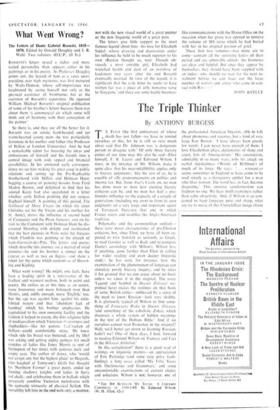What Went Wrong?
The Letters of Dante Gabriel Rossetti, 1835- 1870. Edited by Oswald Doughty and J. R.
Wahl. Two volumes. (0.U.P., £8 8s.) Rossurres letters reveal a richer and more varied personality than appears either in his paintings or in his poetry As Professor Doughty points out, the legend of him as a vales sacer, presiding over high mysteries, was first nurtured by Watts-Dunton, whose self-importance was heightened by seeing himself not only as the physical caretaker of Swinburne, but as the sacristan of Rossetti's reputation. He opposed William Michael Rossetti 's original publication of some of his brother's letters because there was about them 'a commercial air which some will think out of harmony with their conception of the painter.'
So there is, and they are all the better for it. Rossetti was an astute, hard-headed and yet warm-hearted young man—he was particularly fortunate in his mother and father (the Professor of Italian at London University). And he had a remarkable talent for focusing the ideas and enthusiasms of himself and his friends into a central image with wide appeal and financial possibilities. In his animated early correspon- dence we see him making his great coup in public relations and setting up the Pre-Raphaelite Brotherhood with Millais and Holman Hunt; begging a course of painting lessons from Ford Madox Brown; and delighted to find that his adored Keats had also speculated in a letter whether early Italian painting did not surpass Raphael himself A painting of this period, The Girlhood of Mary Virgin (in which his sister Christina sat for the Virgin and his mother for St. Anne), shows the influence at second hand of Carpaccio and the Pisan frescoes; and on his visit to the Continent with Holman Hunt he dis- covered Memling with delight and maintained that the best pictures in Paris were the frescoes which Flandrin was painting at the church of Saint-Germain-des-Pres. The letters and poems which describe this journey are a marvel of vivid promise—he sent his brother a sonnet on the cancan as well as two on Ingres—and show a talent for the genre which reminds us of Brown- ing and Kipling.
What went wrong? He might, one feels, have been a leading spirit in a renaissance of the liveliest and warmest realism, both in paint and poetry. He strikes us at this time as an acuter, more humorous and more balanced man than Morris, and, oddly enough, more 'English,' too. But the age was against him, against his unin- hibited nature and that 'abundant lack of humbug' which his brother emphasises. He capitulated to his own romantic facility and the fashion it helped to create, the dim religious light of mediaevalism which Victorian shopowners and shipbuilders—like his patron, McCracken of Belfast—could comfortably enjoy. He knew which side his bread was buttered, and by 1865 was asking and getting eighty guineas for small sketches of ladies like Janey Morris (a sort of Shrimpton of her time), with goitrous neck and empty eyes. The author of Jenny, who 'would not assign any but the highest place' to Hogarth, who laughed at Tennyson's Idylls but thought his 'Northern Farmer' a great poem, ended up limning shadowy knights and ladies in furry red chalk; and celebrating them in ballads which perversely combine Victorian melodrama with the syntactic virtuosity of classical Italian. His versatility left him in the end with only a manner,
not with the new visual world of a great painter or the new linguistic world of a great poet.
The letters give little support to the most famous legend about him—his love for Elizabeth Siddal—whose drawing and decorations under his influence he held to be much superior to his own (Ruskin thought so, too). Though ob- viously a most amiable girl, Elizabeth had wretched health and died of an overdose of laudanum two years after she and Rossetti eventually married In view of the legend, it is significant that the oaly letter he seems to have written her was a piece of jolly nonsense verse to `Guggum, and there are some highly business- like communications with the Home Office on the occasion when her grave was opened to retrieve the volume of MS verse which he had buried with her in his original passion of grief.
These first two volumes—two more are to come—contain all the surviving letters of their period and are admirably edited: the footnotes are clear and helpful. But since they appear by themselves, they should have been supplied with an index—why should %se wait for the next in- stalment before we can trace out the large number of writers and artists who came in con- tact with Ros,,
JOHN BAYLEY


































 Previous page
Previous page